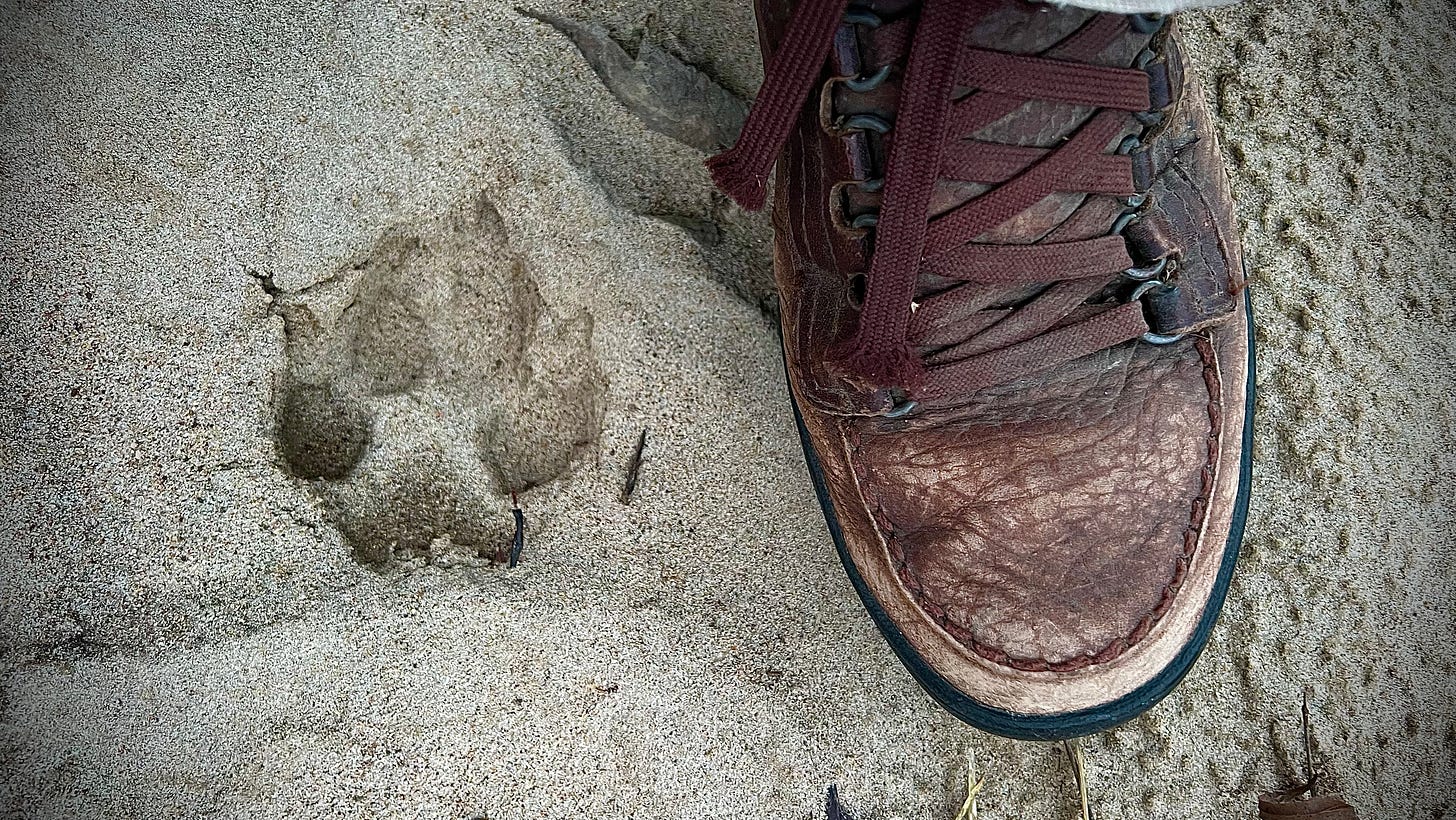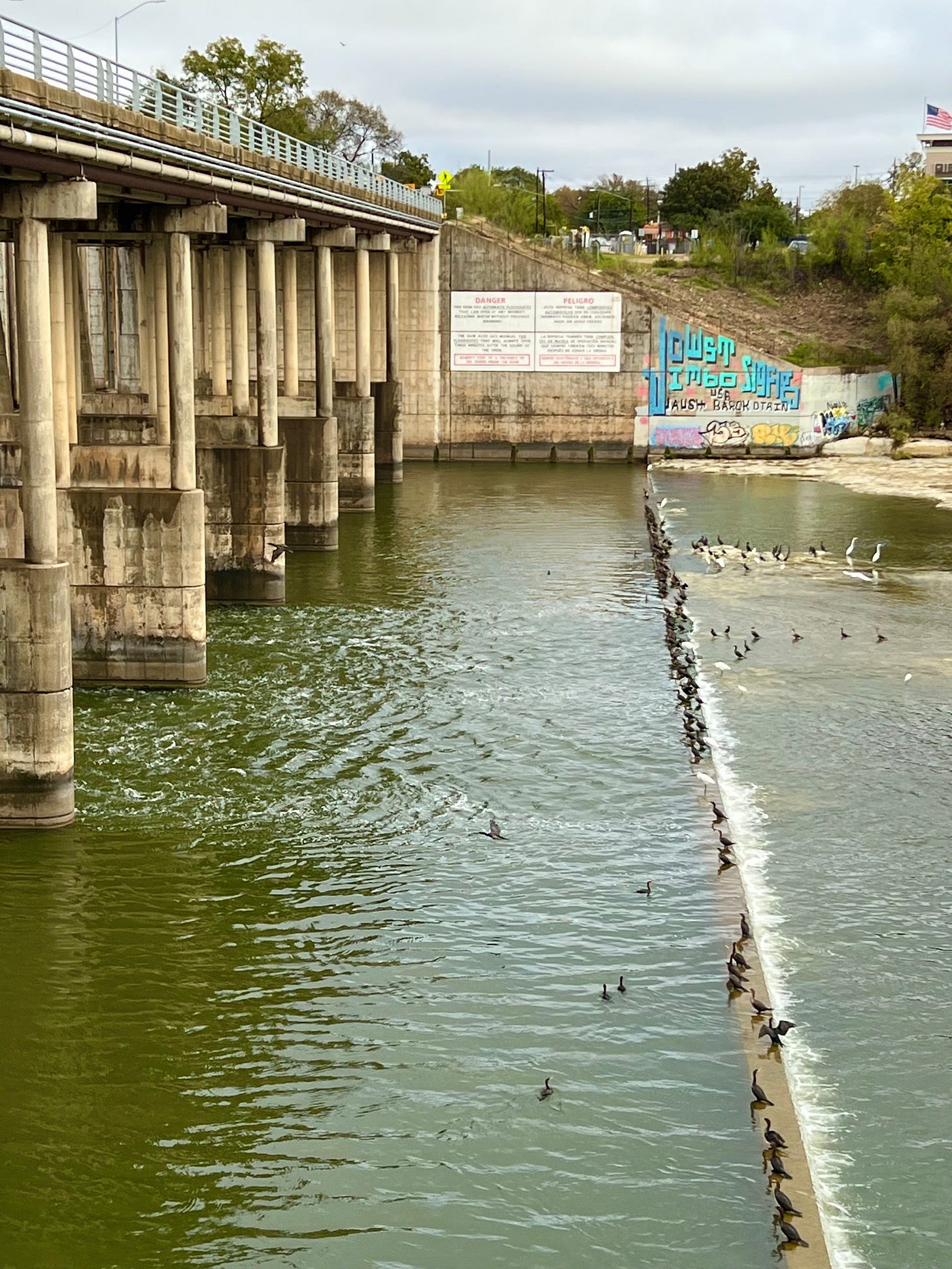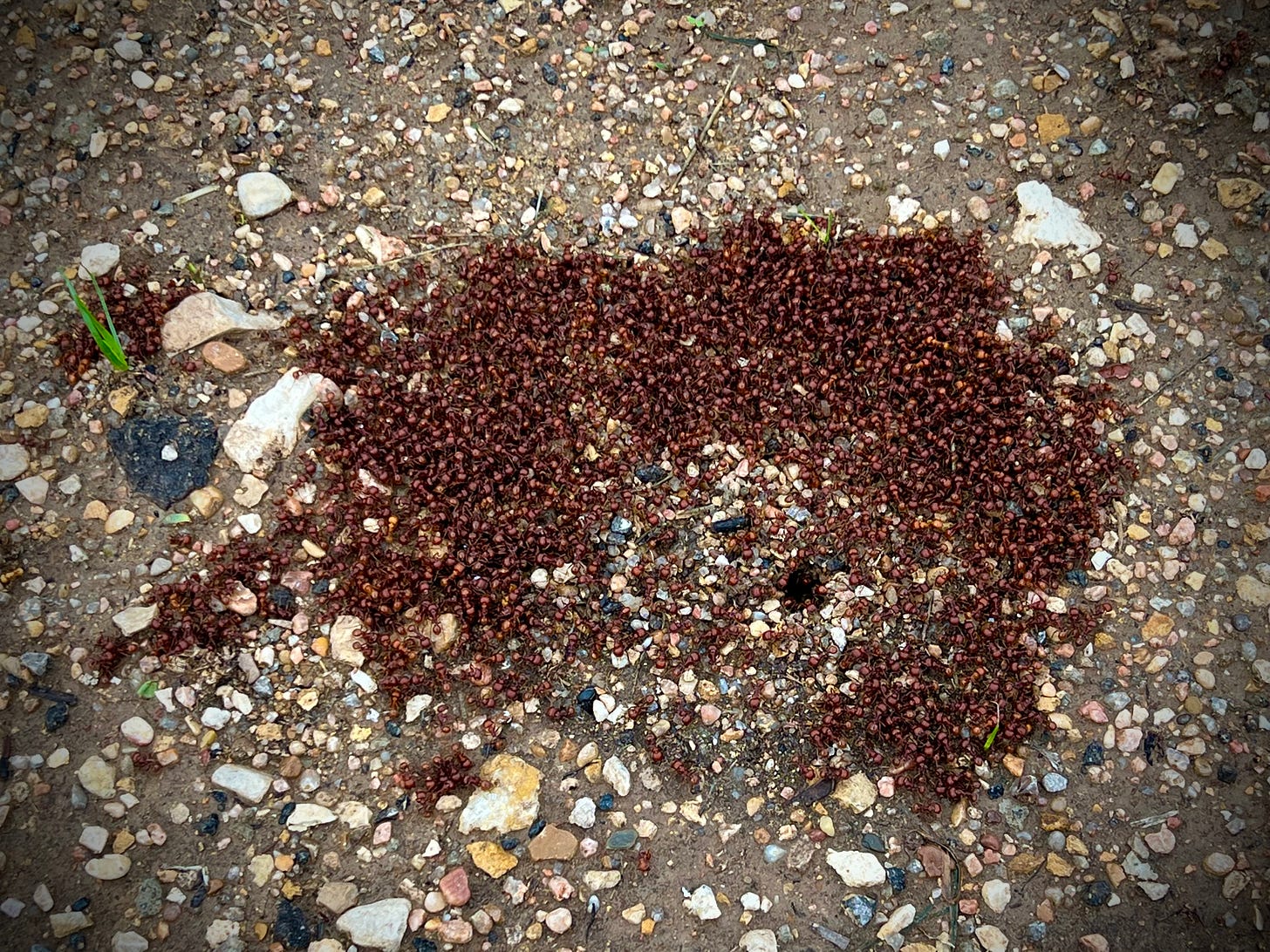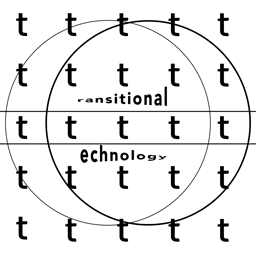Up the creek (with robots, eagles & rogue males)
No. 125
The robots are loose in downtown this fall. Little white hatchback robots with nine eyes, four wheels, California license plates and clever pet names like Sasquatch, Poppy and Tostada. In the new year, they plan to be available to give you a ride, as they currently do in San Francisco, at night. In the meantime, they are practicing, following the pre-programmed routes their masters have mapped, and taking advantage of a legal environment that is friendlier to corporate robots than border crossers.
In the afternoons you can see them with their human handlers at the row of charging stations behind the old power plant, near one of the low water crossings where the cowboys used to gather to rest their horses. Unlike horses, the robot cars expose their interior organs when they are fueling up, their back hatches opened to reveal a massive load of terrestrial avionics that must be cooling off, offloading its data, or both. What’s in there looks like when you could see under the skin of Steve Austin, the Six Million Dollar Man. If the handlers look up from their phones and catch you looking, they will quickly close the hatches.
Chances are neither the robots nor their handlers are equipped to see the new shanties that recently appeared in the right of way along the main road near our house. I only noticed them because I unwisely run along the narrow width of earth they occupy, between the shoulderless eastbound lane of a high-speed thoroughfare leading to a highway, and the fence that protects an empty lot owned by the son of the richest trial lawyer in Texas. On the other side of the fence is a beautiful six-acre meadow leading down to the wild river where it flows out of the dam, but you wouldn’t notice that looking at the corrugated metal panels that hide it. Not unless you heard the whistle of the osprey, and looked up.
The distance between the edge of the road and the property line of the private lot is insanely small, a narrower setback than current code would permit. It’s just wide enough for a car to parallel park in the dirt, as do the patrons of the nearby restaurant owned by the scion of one of the state’s most renowned ranching families, risking their lives to walk along the road’s edge to get to their steak dinner. And yet, in the stretch where the fence is hidden by a stand of weedy trees that have managed to grow in the median, two shelters have been made with that fence as their backing, from pallets, tarps and other found materials of this still-industrial corner of town, literally hiding in plain sight, folded so cleverly into the margins of the city it is almost as if they carved their shelter out of the two remaining dimensions.
The shelters made me think of the burrow the unnamed protagonist of Geoffrey Household’s Rogue Male, on the run after a failed effort to assassinate Hitler before the war, hides in at the side of a road in Dorset. Then one night, driving, I saw the occupants out there, with a campfire between their two post-industrial lean-tos, and thought of the moment in Terry Bisson’s “Bears Discover Fire” where the narrator first sees the bears around a campfire they have made in the interstate median. But this isn’t a story about unexpected evolution. It’s about people being left to fend for themselves with the skills of our ancestors, trying to survive in the liminal spaces that are all we have left of the commons.
I’ve been thinking a lot about the urban commons lately, working on a chapter of my forthcoming book about how to find wild spaces in the interstitial city. In the taxonomy of the sorts of places you can go in a city to find pockets of unexpected wilderness, creeks are high on the list. You are almost always close to one, and while they are often on private property, they are usually safe to walk. You can sneak through the brush at the back of a subdivision, and quickly find yourself stumbling into traces of the deep past. And perhaps most importantly, creeks are places where it is easy to get lost, often very quickly, no matter how experienced a navigator you may be. The word itself embodies that understanding. It’s an old word with deep roots in early English (creke, kryk), Anglo-French (crique), and Old Norse (kriki) variants. It encodes the idea of a small inlet, stream, or brook, but it also has connections to the word crook with its evocations of bends and turns and, when anthropomorphized (as in crooked), lies and tricks. No wonder American soldiers lost on patrol (or otherwise in trouble) in World War Two liked to say they were up the creek (or up shit creek).
I conducted an experiment in creek confoundment the weekend before Thanksgiving. Not in an urban creek, but a rural one, as I was in Southern Iowa retrieving my recently widowed mother to come spend the holidays with us. I decided to do it at dusk, to amp up the effect, on a day when the first words that came through my mom’s television in the morning were the regional weatherman saying “it feels like two below.” A feeling I confirmed when I went out for windy trail runs along the edge of the property two days straight. But the early snow was still shallow and dry, and when I got to the western ridgeline, I saw eagles.
The night before I had been reading in one of the old nature books from my parents’ kitchen shelf about how hard it is to distinguish between eagles and vultures when they are in flight. Partly, explained the authors, because eagles, while they can adapt well to our infrastructure and the opportunities it creates, “need a measure of solitude and space to accommodate their size.” Or maybe they just know better than to let us get too close. Unless they are juveniles, like the one we encountered in a nearby field after my dad’s memorial.
I encountered more eagles on my way to the creek that Friday evening, down in a wetland that had frozen over. One of them is in the above picture, soaring over the treeline of a wintry landscape that harbors more life than its minimalism would suggest. To find the wetland you follow an old road that has devolved into a wide trail, a trail that looks a lot like the Spanish caminos you can find photos of in the nerdy books about the history of American roads I have been reading lately. One of those roads that feels closer to its roots as an Indian trail, and probably an animal trail before that, a trail that now, as agriculture recedes from the more feral corners of Iowa, mostly transports turkey and deer. When I stepped out into the clearing I watched the eagle for a while, as it turned away, then cut back and alighted on a high branch, in a spot where it could watch me but I would have a hard time watching back.
The creek was wetter than it had been a month before, partially covered in ice, but none of it thick. That week had been the first real freeze of the season, and the precipitation flushed most of the leaves and acorns down from the bur oaks, bringing out the forest’s gothic quality, especially at dusk. The sand and mud of the creek were full of tracks, canine and cervid and occasionally avian, all frozen into place. Some of the coyote prints were huge, maybe distorted by weathering, maybe not. It heightened the sense of risk, maybe because of the diminishing sun, and the knowledge that it was hunting season for humans, too.
Time stretches out when you try to follow a creek, not just because it is such a slow and inefficient way to travel through space. I wanted to avoid getting wet given the cold, so I kept having to scramble from side to side as the banks cut back and forth. I heard a low-flying small-engine aircraft, but couldn’t see it, even though I could still see traces of blue sky through the low clouds. The light started to really bleed off fast, and then I found myself at a fork, and unsure which way to go to get back. Lost, in a network hole where my phone would not help.
I took the channel to the left, thinking it was in the right general direction, only to find it impassable. So I backtracked, and walked a good ways until I came to a road, which I knew was the wrong direction. I climbed the bank, and bushwhacked my way back toward the other channel, finding what may have been a third way. The sun was officially set, it was getting quickly colder, and I had no light. But then I finally came upon the bridge at the end of the driveway, and was able to climb up onto it. And get back to the house just in time to join my 82-year-old mom for her nightly viewing of Wheel of Fortune and a double-dose of Perry Mason.
The fences in that part of Iowa are mostly old and disused these days, as economic entropy has let much of the land go back to wild, some of it now owned by wealthy hunters from out of state. The population in that county peaked 120 years ago, and is so depopulated now that even the enclosure of private property that is so fundamental to the mid-American landscape is starting to erode. I’ve been thinking a lot about the history of enclosure, especially in the context of urban enclosure and how animals often defy it, and when you see a part of the country where the maintenance of property lines is diminishing, it makes you wonder what the future could be like.
On the flight back to Texas I read an article by the Canadian historian Allan Greer about the role of the commons and enclosure in the colonization of North America. The story we are often told is a simple one. How people (English people, specifically) once lived in relative communal harmony, even though they owed certain services to the lord as a condition of their tenure, and much of the land that sustained the community was managed in common. How the modern era brought a movement to enclose the land, usually to dedicate it to a more specialized and profitable agricultural pursuit, such as the raising of sheep to take advantage of the 17th and 18th century European demand for wool. And how that idea of enclosure was exported with the English colonists to the New World, a place that was occupied by its Native peoples as one gigantic continental commons.
The truth, contends Greer, is more complicated. The tribes of North America mostly had some form of agriculture, and managed commons that were often shared in whole or in part with neighboring tribes. What they did not have, what was so alien, was pastoral culture—domesticated livestock. The early colonies, in both Spanish and English America, were not entirely characterized by enclosure. They had a mix of private and communal property, a pattern which one could argue persists into the present, even if the commons are now mostly dedicated to infrastructure. And the irony is that the immediate cause of the dispossession of Native peoples was not enclosure, but the commons—open land that the early settlers shared with the Indians, but used for free-range ranching (cattle and sheep in Mexico, cattle and hogs in the American colonies) that wrought rapid ecological destruction that preceded the introduction of private property rights. A very different tragedy of the commons than the one the economists used to want us to believe.
When we got back, it rained all week through Thanksgiving, culminating in a big thunderstorm Friday night. The wind finally cleared the clouds, and my visiting son and I went for an urban trail run Saturday morning. On the spillway of the dam we witnessed a massive gathering of urban waterfowl: cormorants, egrets & herons waiting for the rush of water to flush the big fish from the bottom of Town Lake. And on the way, we passed those shelters on the shoulderless road.
I stopped to take another picture, planning to write about it. And when I put my phone down, I found myself looking at one of the guys who stays there. A kid, younger than my son, standing with a bike and a balaclava-style face mask he had just pulled down. I asked him if he was doing okay, as if that wasn't the stupidest question to ask. He didn’t answer. Behind the pallets, you could see some of the stuff they had liberated from wherever they found it. In the moment, rich with the romantic stealth and menace of the thief. Spider-man as homeless teen, walking through walls instead of climbing them. Unmasked as he encounters a different sort of thief, an interloping writer, a person who steals without carrying anything away.
We ran on. Toward the end of the run, I noticed this clump of harvester ants gathered around the entry to their subterranean lair, even closer to the edge of the roadway than those shanties. Hundreds, maybe thousands of ants, huddling in the cold. They must have been flooded out by the storm that woke us before dawn. Another species that seems to share our proclivity for denuding its domain of all other life, if on a more manageable scale. And as I got to thinking later about whether that kid was the descendant of indigenous peoples who got dispossessed by our idea of how to manage the land in common, I found myself wondering when those practices will bring the storms that flood us out, to live in the ruins of the world we partitioned.
Maybe the robots will help us find our way out.
Further reading
You can find Allan Greer’s 2012 article “Commons and Enclosure in the Colonization of North America,” originally published in The American Historical Review, here. Or you can read Greer’s 2018 book, Property and Dispossession: Natives, Empires and Land in Early Modern North America.
For a deeper background on the conflict between the commons and private property in England, Simon Fairlie’s “A Short History of Enclosure in Britain,” at The Land, is a good place to start.
For a more contemporary account of the conflict between the commons and private property rights, this weekend’s New York Times has a fascinating story about hunters who have been using digital mapping apps to hack physical access to landlocked public lands. “It’s Public Land, But the Public Can’t Reach It,” by Ben Rider Howe. Bonus for the overlap with the work of Annie Proulx.
This week’s New York Review of Books has an interesting article by the philosopher Martha Nussbaum with a fresh take on the ideas expressed by the rights of nature movement and some notes towards a post-Anthropocene ecology. She has some far out speculations about whether there is a moral imperative to intervene in wild nature to mitigate the pain and terror that comes when predator meets prey. I’m not sure her provocations are all that persuasive, but they carry a moral weight that merits deeper consideration. You can find “A Peopled Wilderness” here, currently behind the paywall, but that should change once the next issue comes out.
The bird book I was reading at my folks’ kitchen table was Hawks in Flight (1988) by Pete Dunne, David Sibley and Clay Sutton, which includes this amazing passage about osprey nests:
Nest-building materials may include natural material such as wrack weed, desiccated carcasses of Great Blue Herons, and conch shells or even nylon webbing from beach chairs, plastic garbage bags, discarded toys, and fish line and lures… Ospreys are open to suggestion concerning their nest sites and are quick to adapt to man-made structures. The birds have built nests on duck blinds, outhouses, channel markers, grounded boats, and, of course, telephone poles—a preference that hasn’t endeared the bird to the power companies. One colony in southern New Jersey uses the support struts for high-tension towers that cross open marsh.
If you want to read about the history of American roads and their connection to ancient trails, there is a minor genre of invisible literature produced by highway departments, and some of it made its way into books. One of the fresher ones is Miles and Miles of Texas by Carol Dawson and Roger Allen Polson, published in 2016 on the centenary of the Texas Highway Department. Some other great ones in my library are Chicago’s Highways Old and New: From Indian Trail to Motor Road (1923), by Milo M. Quaife, Old Trails and Roads in Penn’s Land (1927), by John T. Paris, and Indian Trails of the Southeast (1971) by William Myer. Related, and a better read, is George Stewart’s Names on the Land: A Historical Account of Place-Naming in the United States, originally published in 1945 with a new 2008 edition from New York Review Books.
Lastly, on the occasion Saturday of the 100th anniversary of the birth of cartoonist Charles Schulz, the pianist Ethan Iverson shared this great 2017 New Yorker piece he wrote about Vince Guaraldi, who I only really learned to appreciate when I heard him outshining the bandleader on some early Cal Tjader records. Off topic for this urban nature newsletter, you might think, until you learn that, layered over the syncopated left hand ostinato of the seasonally ubiquitous “Linus and Lucy” are horn fifths: the sound long used by European composers to evoke the horns of the hunt. A sound of the commons, and of one way of connecting with our ancestral nature.
*If you like smart writing about jazz and classical music, by a working musician, Ethan’s newsletter Transitional Technology on this platform is pretty great—I’ve been reading his blogs as long as I’ve been listening to his music, close to 20 years:
Have a good week, and keep an eye out for osprey nests. And if you’re up early, look for Mars and Saturn in the western sky, in the weird inky hour after the new moon disappears and before the sun starts to rise.














Good reading first thing in the morning!
Yeah, me too, but we'll be back in South Austin again in the spring and meet up soon.